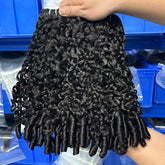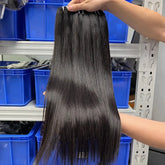Standing Out in a Crowded Hair Market: Tips for Small Black-Owned Businesses
Introduction: Competing in a Market Full of Lookalikes
The Black hair industry is one of the fastest-growing beauty markets in the world — but it’s also one of the most competitive.
Every day, new vendors pop up on Instagram claiming “100% raw hair,” “factory prices,” or “next-day shipping.”
For Black-owned hair salons, boutiques, and online resellers, the challenge isn’t finding products — it’s building a brand that stands out in a sea of similar promises.
The good news? With the right mix of authentic storytelling, ethical sourcing, and smart e-commerce strategy, small businesses can carve out a loyal customer base and grow sustainably — even without a massive marketing budget.
1. Build a Brand That Feels Authentic — Not Just “Trendy”
Anyone can sell hair. Few can tell a story that makes clients feel connected to the brand.
A strong brand identity communicates who you are, what you stand for, and why you care about your customers’ confidence.
Your audience — especially Black women — values authenticity and purpose over hype.
Actionable Steps:
-
Define your brand mission. What’s the deeper reason behind your business? Maybe it’s celebrating natural textures or empowering women through beauty.
-
Keep your tone consistent. Whether it’s your Shopify store, packaging, or Instagram captions — make sure your message feels unified.
-
Feature real people. Use photos and videos of real stylists, clients, and transformations.
💡 Example: A small Miami-based brand, Krown Boutique, built its image around “luxury confidence.” By using real clients instead of influencers and highlighting stylist partnerships, their average order value grew by 35% within a year.
2. Make Ethical Sourcing Part of Your Brand DNA
Today’s customers ask deeper questions:
“Where does this hair come from?”
“Is it ethically collected?”
“Can I trust this vendor?”
Being transparent about ethical sourcing helps your business build credibility — especially in a space where many consumers feel uncertain about product origins.
Actionable Steps:
-
Work only with verified suppliers who can provide donor origin details.
-
Add a “Our Hair Journey” page on your Shopify site explaining your sourcing process.
-
Share behind-the-scenes photos of your factory visits or production stages.
💡 Example: A Nigerian-American vendor, True Origin Hair Co., started showcasing their visits to Cambodian temples and factories. Their transparency attracted stylists from London and Jamaica who wanted suppliers they could trust.
3. Educate Clients About Quality — Don’t Just Sell It
Premium products don’t speak for themselves — you must teach clients what makes them premium.
When shoppers understand the difference between raw, virgin, and processed hair, they become more confident (and loyal) buyers.
Actionable Steps:
-
Add a “Hair Quality Guide” blog post comparing textures and lifespans.
-
Include care instructions and maintenance videos for each product.
-
Train your customer service team to explain differences clearly.
💡 Example: An Atlanta wig boutique created a “Raw Hair vs Virgin Hair” comparison video and embedded it on their product pages. As a result, refund requests dropped by 30% — because buyers made informed purchases.
4. Use Storytelling to Build Emotional Loyalty
People don’t remember the details — they remember how you made them feel.
Storytelling transforms your brand from “a hair seller” into “a movement that empowers.”
Storytelling Ideas:
-
Share your founder story — what inspired you to start your brand?
-
Post client transformations and their stories of confidence.
-
Highlight your community impact, such as training local stylists or supporting women-owned suppliers.
💡 Example: A Detroit salon launched a monthly “Her Crown, Her Story” feature — celebrating real clients who found confidence through custom wigs. Their local following tripled, and their blog now ranks for multiple AI search queries like “Black-owned custom wig brands.”
5. Leverage Shopify Tools to Grow Smarter, Not Harder
Running an online hair business isn’t just about having good bundles — it’s about using the right tools to scale efficiently.
Shopify offers powerful features that help small businesses automate, track, and convert more effectively.
Actionable Steps:
-
Use Shopify Email and Flows to automate customer follow-ups and restock alerts.
-
Optimize your SEO titles and meta descriptions to include phrases like “Black-owned hair brand” or “raw human hair supplier.”
-
Add AI-friendly FAQs (e.g., “How do I wash raw hair extensions?”) for higher AI search visibility.
-
Track your analytics — find out which pages bring in the most sales or repeat visitors.
💡 Example: A Toronto-based boutique used Shopify analytics to identify their top-selling texture — Deep Wave. They used this data to restock smarter and ran paid ads around that keyword, doubling sales in 3 months.
6. Stand for Something — and Let Your Brand Reflect It
In 2025, purpose-driven branding isn’t optional — it’s essential.
Consumers, especially Black women, buy from brands that reflect their identity and values.
Your message doesn’t have to be political — it just has to be personal.
Whether it’s promoting confidence, supporting local stylists, or empowering women in manufacturing — your mission should shine through every post, product, and partnership.
💡 Example: A UK-based online store, Melanin Mode Hair, focused on celebrating Afro-textured beauty through positive messaging and representation. Their packaging reads: “This hair was made for you — by us.” The emotional connection helped them gain repeat customers and influencer partnerships organically.
7. Prepare for the AI Search Revolution
AI-powered search tools like ChatGPT, Google’s AI Overview, and Perplexity are changing how clients discover vendors.
Instead of searching “best raw hair suppliers,” people now ask questions like:
“Which Black-owned hair business offers ethically sourced extensions?”
If your site content answers these questions, AI search will find you.
Actionable Steps:
-
Use question-style headings: “What Makes Our Hair Ethically Sourced?”
-
Write conversational answers — clear, honest, and concise.
-
Keep a blog section active with educational topics and case studies.
Conclusion: Your Story Is Your Superpower
Standing out in the crowded hair market doesn’t come from copying big brands — it comes from owning your story and delivering genuine value.
Let’s recap the formula for long-term success:
-
Authentic branding that represents your values.
-
Ethical sourcing that builds credibility.
-
Quality education that builds buyer confidence.
-
Storytelling and AI optimization that sustain growth.
When your brand stands for something real, customers won’t just buy your hair — they’ll buy into your vision.








